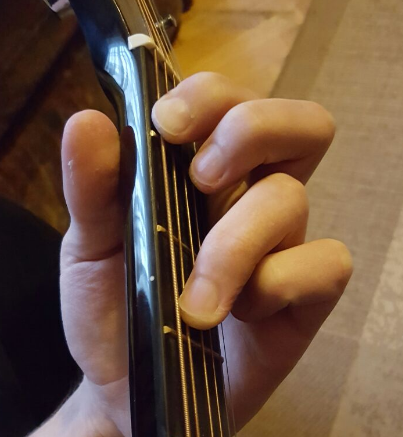Six months ago I started to play the guitar. I like it very much. It became one of these things that I regret not started earlier in my life (I am 25 years old)! By now I can say I am not a complete beginner anymore. I practice whenever I can (about 7 hours per week).
One thing that bothers me a lot is that I seem to be unable to spread my index finger and ring finger far enough to play power chords like the F5:
When I play this chord with not investing much effort it looks like this:
By no effort I mean that my hand and my upper body are relaxed and under no tension. My left arm is leaned onto my body. The guitar is resting comfortably on my leap and is slightly pointing away from me.
When I try hard to play the chord perfectly, so the fingers are in a 90 degrees angle to the strings, it looks like this:
As you can see it is slightly better. But to achieve this I have to put much more effort in my body tension. I have to position the guitar a little bit outside my lap so I can achieve a 90 degrees angle between my arm and the guitar neck. Also I have to move my left arm a little bit away, so it is not leaned against my body anymore.
I met other guitar players and explained my problem to them. They seemed totally unaware of this so it makes me think that I might be one of few "anatomically disadvantaged" guitar players. Is anybody experiencing (or has experienced) this problem?
Update
I want to thank all of the answerers for encouraging me. It really boosted my will to play guitar even more. Additionally I lowered my strings on my guitar, because they were way to far from the fretboard. Now it is even easier to play this chord. It does not sound nasty because I don't need that much force anymore.






